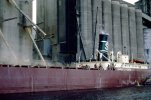1. With shipping blocked from using the Black Sea ports, is the railway to the Baltic the only other route to export grain, although it means a change of gauge somewhere?
2. Are grain wagons a special design, or can general purpose ones be used? Presumably they need a roof to keep the rain off, and a means of loading/unloading.
3. Do many goods wagons exist that can exchange bogies, or have some other means of changing gauge, or would it mean transshipment?
(Thanks in advance)
2. Are grain wagons a special design, or can general purpose ones be used? Presumably they need a roof to keep the rain off, and a means of loading/unloading.
3. Do many goods wagons exist that can exchange bogies, or have some other means of changing gauge, or would it mean transshipment?
(Thanks in advance)



